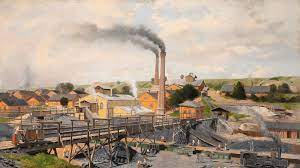“Contextualizing Industrialization and Its Origins and Effects” Everything You Need to Know
Imagine a world where handcrafted goods gave way to the roar of factories, where the pace of life shifted from the slow rhythms of rural existence to the rapid pulse of urban centers. Did you know that the Industrial Revolution not only revolutionized how products were made but also reshaped social structures, economies, and even cultural identities? In this comprehensive guide, we delve into Contextualizing Industrialization and Its Origins and Effects by examining how industrialization emerged, the forces that drove it, and its lasting impacts on our modern world. Whether you’re a history enthusiast, a student of economics, or simply curious about how modern society came to be, this article will provide an in-depth look at one of the most transformative periods in human history.
Introduction: From Handcraft to Mechanization
The shift from an agrarian society to one dominated by machine-driven production stands as a turning point in world history. Industrialization transformed every aspect of life—from the way goods were produced and distributed to the organization of society and the rise of new economic systems. This transformation, which began in the late 18th century and spread across the globe, was fueled by groundbreaking technological innovations, evolving economic policies, and dramatic social changes.
A Captivating Hook
Imagine living in a time when nearly all work was done by hand, and a revolutionary invention could change everything. How did the advent of steam engines, mechanized looms, and factories disrupt traditional ways of life? What were the origins of industrialization, and how do its effects continue to influence our modern economies, urban landscapes, and cultural identities? In this post, we explore Contextualizing Industrialization and Its Origins and Effects to uncover the complex interplay between tradition and innovation that still resonates today.
What This Article Will Cover
In this article, we will:
- Define “Contextualizing Industrialization and Its Origins and Effects”: Provide a clear explanation of the concept and its essential characteristics.
- Explore Historical and Contextual Background: Trace the origins of industrialization, examining key milestones, technological breakthroughs, and the socio-economic conditions that made this transformation possible.
- Delve into In-Depth Themes: Break down major aspects such as technological innovations, urbanization, economic transformation, social change, and cultural shifts, using real-world examples and case studies.
- Discuss Importance, Applications, and Benefits: Explain why understanding industrialization is crucial for grasping modern economic and social systems and how these insights can inform policy and business strategies.
- Address Common Misconceptions and FAQs: Clarify prevalent myths and answer frequently asked questions about industrialization and its multifaceted impacts.
- Review Modern Relevance and Current Trends: Explore how the legacy of industrialization informs today’s digital economy, urban planning, and global environmental challenges.
- Conclude with Key Takeaways and a Call-to-Action: Summarize the main insights and encourage further exploration and discussion.
By the end of this exploration, you will have a comprehensive understanding of Contextualizing Industrialization and Its Origins and Effects and appreciate the profound changes that have shaped our modern world.
What Is “Contextualizing Industrialization and Its Origins and Effects”? A Clear Definition
Defining the Concept
Contextualizing Industrialization and Its Origins and Effects involves examining the transformative process by which economies shifted from agrarian and artisanal systems to industrial, machine-driven production. It entails understanding not only the technological innovations that powered this change but also the socio-economic, cultural, and political forces that both preserved traditional practices and spurred radical innovation.
Essential Characteristics
Technological Innovation:
The development and widespread use of machines—such as the steam engine, power looms, and mechanized tools—revolutionized production methods.Economic Transformation:
Industrialization shifted economies from localized, hand-produced goods to mass production and global trade, leading to the rise of modern capitalism.Urbanization:
The growth of factories and industrial centers drove mass migration from rural areas to cities, fundamentally altering social structures and urban landscapes.Social Change:
New social classes emerged, traditional hierarchies were redefined, and the very notion of work and labor underwent significant transformation.Cultural Impact:
The dramatic changes in production and society influenced art, literature, and public discourse, giving rise to movements that critiqued industrial life and celebrated human creativity.Environmental Effects:
Industrial processes dramatically altered the natural environment, creating challenges such as pollution and resource depletion that persist today.
Historical and Contextual Background
Pre-Industrial Foundations
Before industrialization, economies were predominantly agrarian. Most goods were produced by hand, and economic activity was localized. Life was governed by seasonal cycles, and production was limited by manual labor and simple tools.
Key Features of the Pre-Industrial Era
Artisanal Production:
Goods were made in small workshops or in homes, often by craftsmen who passed skills down through generations.Agrarian Economy:
The majority of people lived in rural areas, working the land to produce food and raw materials.Limited Technological Innovation:
While innovations did occur, they were often incremental and localized, lacking the widespread impact seen during industrialization.
Catalysts for Industrialization
The Industrial Revolution began in Britain in the late 18th century, driven by a convergence of factors that set the stage for rapid economic and technological change.
Technological Breakthroughs
The Steam Engine:
James Watt’s improvements to the steam engine revolutionized energy production. No longer limited by human or animal power, factories could operate continuously, dramatically increasing productivity.Mechanization of Textile Production:
Inventions like the spinning jenny and the water frame mechanized the production of textiles, a key industry that propelled industrial growth.Advances in Iron and Steel Production:
New techniques in metallurgy enabled the production of stronger, more durable materials, essential for building machines, railways, and infrastructure.
Socio-Economic Conditions
Population Growth:
A rising population increased the demand for goods and provided a steady supply of labor for emerging factories.Economic Incentives:
A surplus of capital, driven by colonial trade and mercantilist policies, provided the financial resources necessary for investment in new technologies and infrastructure.Political Stability and Legal Frameworks:
Britain’s relatively stable political environment and its legal system, including property rights and contract law, fostered an environment conducive to economic experimentation and innovation.
Historical Milestones and Anecdotes
The Birth of the Factory System:
The establishment of factories in cities like Manchester and Birmingham marked the beginning of a new era in production. These centers of industrial activity became symbols of modernity and economic progress.The Railway Revolution:
The expansion of the railway network in the 19th century transformed transportation, making it faster, cheaper, and more efficient to move goods and people over long distances. This innovation not only boosted industrial growth but also reshaped urban development.
In-Depth Exploration: Key Themes and Effects of Industrialization
To fully appreciate Contextualizing Industrialization and Its Origins and Effects, we must explore the multifaceted impacts of this transformative period. The following sections break down the major themes with detailed analysis, real-world examples, and case studies.
1. Technological Innovation and Mechanized Production
Breakthrough Inventions
Steam Power:
The steam engine enabled factories to operate independently of natural energy sources like water. This breakthrough spurred the growth of industrial manufacturing and revolutionized transportation with steamships and locomotives.Textile Machinery:
Mechanized devices such as the spinning jenny, water frame, and power loom drastically increased the efficiency of textile production, making textiles one of the leading industries of the Industrial Revolution.
Impact on Production Methods
Mass Production:
The shift to factory-based production allowed for the mass production of goods, reducing costs and increasing availability. This laid the foundation for modern consumer culture and global trade.Division of Labor:
Specialization in the workplace led to the division of labor, where each worker performed a specific task. While this increased efficiency, it also introduced challenges related to worker satisfaction and job security.
Real-World Example: The Textile Industry in Manchester
- Manchester as a Model:
Known as “Cottonopolis,” Manchester epitomized the industrial boom. Its factories churned out textiles at unprecedented rates, attracting workers from across the country and transforming the city into an economic powerhouse. The growth of Manchester illustrates both the opportunities and the social challenges brought about by industrialization.
2. Urbanization and Social Change
The Migration from Rural to Urban
Rapid Urban Growth:
As factories proliferated, people migrated from rural areas to urban centers in search of work. This mass movement led to the rapid expansion of cities and significant changes in the social fabric.Challenges of Urbanization:
The sudden influx of workers resulted in overcrowded living conditions, inadequate sanitation, and public health crises. These challenges spurred early urban planning efforts and the development of public infrastructure.
Social Transformation
Emergence of New Social Classes:
Industrialization gave rise to a new middle class—the bourgeoisie—comprising entrepreneurs, industrialists, and professionals. This class gradually gained economic and political influence, challenging the old aristocratic order.Changing Family Dynamics:
The industrial workplace altered traditional family roles, as work moved away from the home and into factories. These shifts contributed to changing social norms and expectations regarding gender and labor.
Case Study: The Urban Landscape of 19th-Century London
- London’s Transformation:
London experienced explosive growth during the Industrial Revolution. The city’s expansion brought both prosperity and social strife, as diverse populations converged in urban environments. Public health reforms, improved housing, and modern transportation emerged as necessary responses to these challenges.
3. Economic Transformation and Global Trade
From Mercantilism to Capitalism
Economic Transition:
Prior to industrialization, many economies operated under mercantilist policies, focusing on state-controlled trade and colonial wealth accumulation. Industrialization facilitated the shift toward capitalism, characterized by free markets, competition, and private ownership.Growth of Financial Institutions:
The need to finance large-scale industrial projects led to the development of modern banking systems, stock exchanges, and other financial institutions. These institutions played a crucial role in supporting industrial expansion and global trade.
Impact on Global Trade
Expansion of Markets:
The increase in production capacity and efficiency allowed for goods to be traded on a global scale. Advances in transportation, such as railways and steamships, connected distant markets and created a truly global economy.Interconnected Economies:
Economic interdependence grew as nations traded raw materials, manufactured goods, and technological innovations. This global network of trade laid the groundwork for modern economic integration and globalization.
Real-World Example: The Global Cotton Trade
- Cotton’s Role in Industrialization:
The demand for cotton drove significant economic activity, linking plantations in the Americas and India with textile factories in Britain. This global trade not only fueled industrial growth but also highlighted the interdependence of international economies.
4. Cultural and Intellectual Effects
Artistic and Literary Responses
Romanticism as a Reaction:
In response to the mechanization and urbanization of industrial life, the Romantic movement emerged as an artistic and literary counterpoint. Romantic artists and writers celebrated nature, emotion, and individualism, offering a critique of industrial society.Cultural Expression:
The changes brought by industrialization were reflected in the arts, from the grandeur of industrial landscapes in paintings to the exploration of urban life in literature and music.
Intellectual Developments
Scientific and Technological Inquiry:
Industrialization spurred scientific research and technological innovation, which in turn influenced intellectual thought. The desire to understand and improve production methods led to advancements in engineering, chemistry, and physics.Educational Reforms:
The growing demand for skilled labor and the spread of technological knowledge resulted in the expansion of educational institutions. Public education reforms laid the foundation for a more informed and literate populace.
Case Study: The Impact of Industrialization on British Literature
- Charles Dickens and Social Critique:
Dickens’ novels, such as Oliver Twist and Hard Times, vividly portray the social challenges and human costs of industrialization. His work remains a powerful commentary on the effects of rapid economic change and urbanization on society.
5. Environmental Effects
Industrialization’s Ecological Footprint
Urban Pollution:
The rise of factories and the rapid expansion of cities led to significant environmental degradation. Air and water pollution became common, and the industrial landscape dramatically altered natural environments.Resource Depletion:
The increased demand for raw materials to fuel industrial production led to the overexploitation of natural resources, with lasting impacts on ecosystems and biodiversity.
Long-Term Environmental Challenges
Legacy of Industrial Emissions:
The industrial era set in motion environmental issues that persist today, including climate change, deforestation, and pollution. Understanding this legacy is crucial for developing sustainable practices in modern industries.Modern Environmental Movements:
The environmental repercussions of industrialization have inspired global movements for sustainability, renewable energy, and conservation, driving efforts to mitigate the adverse effects of industrial progress.
Importance, Applications, and Benefits
Understanding Contextualizing Industrialization and Its Origins and Effects is critical for comprehending the profound changes that have shaped our modern world. Its lessons extend far beyond historical interest, impacting various aspects of contemporary life.
Shaping Modern Economic Systems
Foundations of Capitalism:
The transition from agrarian economies to industrialized, market-based systems laid the groundwork for modern capitalism. This historical context helps economists, policymakers, and business leaders understand the origins of global trade, market dynamics, and financial institutions.Innovation and Productivity:
The technological breakthroughs of the Industrial Revolution continue to inspire innovation today. Modern industries, from manufacturing to digital technology, build on principles established during this transformative period.
Influencing Urban Planning and Public Policy
Urban Development:
Lessons from the rapid urbanization of the industrial era inform modern city planning and public health policies. Strategies for managing urban growth, improving infrastructure, and addressing pollution are directly linked to historical experiences.Policy Formulation:
The economic reforms and regulatory frameworks developed during industrialization provide valuable insights for modern policy-making. Understanding these effects aids in crafting policies that balance economic growth with social equity and environmental sustainability.
Cultural and Social Enrichment
Interdisciplinary Learning:
The study of industrialization integrates history, economics, sociology, environmental science, and the arts, offering a comprehensive perspective on societal change. This interdisciplinary approach enriches education and enhances critical thinking.Cultural Literacy:
Familiarity with the origins and effects of industrialization deepens our understanding of modern cultural expressions, from literature and art to music and public discourse. It helps us appreciate the complex interplay between technology, society, and human creativity.
Practical Benefits for Business and Innovation
Strategic Planning:
Businesses can draw on historical insights from industrialization to develop strategies that foster innovation, adapt to technological change, and remain competitive in a globalized economy.Corporate Social Responsibility:
The environmental and social challenges of the industrial era have led to modern movements for sustainability and ethical business practices. Companies that understand these historical impacts are better positioned to implement policies that promote social and environmental responsibility.
Addressing Common Misconceptions and FAQs
Despite extensive research, several misconceptions about Contextualizing Industrialization and Its Origins and Effects persist. Below, we clarify these misunderstandings and provide quick answers to frequently asked questions.
Common Misconceptions
Misconception 1: “Industrialization is an outdated process that only belongs to the past.”
Clarification:
While industrialization began centuries ago, its principles continue to drive modern technological and economic development. Today’s digital revolution is an extension of the industrial paradigm.Misconception 2: “The effects of industrialization were solely negative.”
Clarification:
Although industrialization brought challenges such as pollution and social inequality, it also spurred technological innovation, economic growth, and improvements in living standards that continue to benefit society.Misconception 3: “All societies experienced industrialization in the same way.”
Clarification:
The process and impact of industrialization varied widely depending on local conditions, cultural contexts, and political factors. Understanding these differences is key to appreciating its complex legacy.
Frequently Asked Questions
Q1: What is industrialization?
A: Industrialization is the process by which economies transition from agrarian and artisanal production to mass production and machine-driven industry, fundamentally transforming social, economic, and cultural structures.
Q2: What were the main technological innovations of the Industrial Revolution?
A: Key innovations include the steam engine, mechanized textile machinery, advances in metallurgy, and the development of transportation networks such as railways and steamships.
Q3: How did industrialization impact urbanization?
A: Industrialization led to rapid urban growth as people migrated from rural areas to cities in search of work. This shift resulted in significant social and infrastructural changes, including overcrowding, public health challenges, and the evolution of modern urban planning.
Q4: Why is understanding industrialization important today?
A: Studying industrialization provides insights into the origins of modern economic systems, technological innovation, and social structures. These historical lessons help inform contemporary policy-making, business strategy, and cultural development.
Modern Relevance and Current Trends
Although Contextualizing Industrialization and Its Origins and Effects is rooted in history, its influence is more relevant today than ever before.
Digital Transformation and the New Industrial Revolution
Industry 4.0:
The digital revolution, characterized by automation, artificial intelligence, and the Internet of Things, is often described as a new phase of industrialization. These technologies are transforming production processes and reshaping economies, echoing the transformative effects of the original Industrial Revolution.E-Commerce and Global Supply Chains:
Modern trade is driven by digital platforms and global supply chains, building on the efficiency and connectivity established during the Industrial Revolution.
Urban Renewal and Sustainable Development
Smart Cities:
Urban planning today incorporates lessons from the industrial era, focusing on sustainable development, efficient infrastructure, and improved quality of life. Smart city initiatives seek to address the challenges of rapid urbanization while harnessing modern technology.Environmental Regulation:
The environmental impact of early industrialization has led to modern policies aimed at reducing pollution, conserving resources, and mitigating climate change. Governments and businesses are increasingly prioritizing sustainability.
Economic Policy and Globalization
Global Financial Systems:
The evolution of global trade and finance during the Industrial Revolution laid the groundwork for today’s interconnected economies. Modern financial markets, international trade agreements, and global economic policies are direct descendants of this transformative period.Entrepreneurship and Innovation:
The entrepreneurial spirit that drove industrialization continues to inspire modern startups and innovation hubs. Lessons in risk-taking, efficiency, and adaptation are as valuable now as they were in the early days of industrialization.
Cultural and Educational Impact
Interdisciplinary Research:
Modern scholarship often combines insights from history, economics, environmental science, and cultural studies to analyze the legacy of industrialization. This interdisciplinary approach enriches our understanding of both the past and present.Public Engagement:
Museums, documentaries, and digital archives make the history of industrialization accessible to a broad audience. These resources foster public understanding of its enduring impact on society.
Conclusion: The Enduring Legacy of Industrialization and Its Effects
Our exploration of Contextualizing Industrialization and Its Origins and Effects has revealed a transformative process that reshaped economies, societies, and cultures. From the revolutionary innovations of the 18th and 19th centuries to the ongoing digital transformation, industrialization remains a cornerstone of modern life. Its impacts—both positive and challenging—continue to influence everything from urban development and economic policy to cultural expression and environmental sustainability.
Key Takeaways
Foundational Transformation:
Industrialization fundamentally altered production methods, leading to mass production, urbanization, and the rise of modern capitalism.Dual Legacy:
While it spurred technological and economic advancements, industrialization also brought significant social and environmental challenges that persist today.Modern Relevance:
The principles and innovations of the Industrial Revolution continue to shape modern industries, urban planning, and global trade, making its study essential for navigating contemporary challenges.Interdisciplinary Insights:
Understanding the origins and effects of industrialization enriches our comprehension of modern society and informs strategies for sustainable development and innovation.
Call-to-Action
Keep Exploring:
Delve further into the history and ongoing impact of industrialization by reading additional resources, visiting museums, or enrolling in courses on economic history and technological innovation.Engage in Discussion:
Share your insights and questions in the comments below. Join online forums or local discussion groups to explore how industrialization continues to shape our world.Apply the Lessons:
Whether you’re a business leader, policymaker, educator, or engaged citizen, use the lessons of industrialization to inform your decisions. Advocate for policies and practices that balance innovation with sustainability and social equity.
By understanding Contextualizing Industrialization and Its Origins and Effects, we not only honor one of history’s most transformative eras but also equip ourselves with the insights necessary to build a more resilient, inclusive, and sustainable future.
Final Reflections
The journey from a predominantly agrarian society to one driven by mechanized industry is a story of profound change—a story that continues to influence every facet of modern life. As we confront the challenges of the digital age, climate change, and global economic integration, the lessons of industrialization remind us of the power of innovation and the importance of balancing progress with sustainability. Through understanding its origins and effects, we gain not only historical perspective but also practical tools to shape the future of our societies.
Thank you for joining us on this comprehensive exploration of Contextualizing Industrialization and Its Origins and Effects. We hope this guide has deepened your understanding of how industrialization transformed our world and continues to impact our lives. Please subscribe for more insightful content, leave your comments below, and share this post with anyone interested in the dynamic forces that have shaped—and continue to shape—our modern society.







